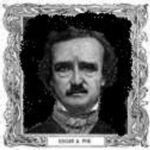Edgar Allen Poe is truly a remarkable writer. For this reason, I chose to analyze his short story, “The Tell Tale Heart”. The nature of the story itself is unique, with a great narrative perspective and an equally impressive sense of accuracy of portraying a madman. The plot, chain of events, and simplicity of the story all work well together to make a classic short story.
The story itself is unique. The reader assumes that the character, who is nameless, is talking in the present tense. Although it could be a police report, diary, or other form of recording, Edgar Allen Poe creates a sense of direct conversation with the reader. In this conversation, the narrator professes he is not mad, and tries to reinforce his claim through re-telling his story. Poe then describes the motive of the murder the narrator commits, which is rather menial. While the narrator still claims he is not mad, it becomes apparent to the reader that this might not be so true. Throughout the telling of the story, Poe descriptively goes from each scene until the events lead up to the killing of the old man that the narrator despises. The chain of events leave nothing to be desired, and nothing to ponder about. The reader is left with a calm sense of simplicity, as there is no threatening problem being posed onto the narrator other than the old man’s eye. However, things become more interesting when the man is dead, and yet, the narrator can still hear his heartbeat. The reader again rethinks the narrator’s statement as being sane. The police come to investigate a shriek in the killing, and the narrator confesses to the crime in a fit of frustration.
The plot is steadily paced, which works well with the chain of events. The introduction most likely one of the most important pieces of the entire story, as it keeps the reader thinking back to the narrators statement on his own sanity, as more is revealed that would suggest otherwise.. Throughout each paragraph after, the narrator shows plausible evidence that the narrator is, in fact, not mad. This perspective is of course, one sided and most likely untrue. The narrator claims his attention to detail and planning make it unlikely that he should be a madman, and he seems to be telling the entire story to prove his sanity.
The simplicity of the story is another strong point. Many short stories will go into too much detail, get off track of the main plot through sub-plots, or offer stories that are much less exciting to read than Poe’s creation. The plot is straight forward the entire read, no backtracking or thinking ahead is necessary. For the story, this works great, and ends just as simply and abruptly. The antagonist, the narrator’s own self, is also quite simple. The setting follows suit, and creates a sense of eeriness upon the reader, even though not much of a description is give. This is most likely attributed to Poe’s descriptive writing of what little description is given. The fact that older clocks and lanterns are being used makes the reader feel estranged and distant from reality.
As for the protagonist, you could say that the narrator’s subconscious mind would be the most likely protagonist here. It drives him to the point of confession, and ends the conflict. “Tear up the planks! Here, here!-It is the beating of his hideous heart!” cries the narrator, showing his guilt and abruptly ending the story.
A moral from this story will be unlikely easy to find, the most reasonable being the classic rule of karma. Everything about this story is wonderfully told, and in a style of writing unlike other works of its publication date. The dreary setting and feelings Poe creates in the reader are impressive. The simplistic manner of the story make it easy to read, and unique perspective is to be noted as well. You can learn a lot from an author from his subject and style of writing, and this story is definitely no exception.



